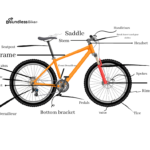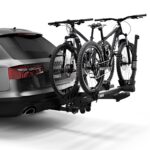If you’re new to biking, the thought of 21 speed bike gears can be daunting. But don’t worry, we’re here to explain what they are and how to use them! Just keep reading and before you know it, you’ll be an expert on shifting gears like a pro. Trust us, it’s not as complicated as it seems. Let’s get started!
What are 21 speed bike gears?
21 speed bike gears are a type of bicycle gearing system that uses three chainrings and seven sprockets to provide 21 different gears. The three chainrings are connected to the pedals and the seven sprockets are connected to the rear wheel. This allows you to use a wide range of gears for various types of riding. For instance, if you’re riding on flat terrain, you can use the lower gears for easy pedaling. If you’re riding up a hill, you can use the higher gears to get the extra power needed to get up the hill.
The three chainrings on a 21 speed bike are usually labeled with numbers (e.g. 44-32-22) to indicate their size. The larger the number, the more teeth on the chainring and the more power it will provide. The seven sprockets in rear wheel are usually labeled with letters (e.g. A-B-C-D-E-F-G) to indicate their size. The larger the letter, the more teeth on the sprocket and the more power it will provide.
The components of a 21 speed bike
- Derailleur: The derailleur is a mechanism that moves the chain from one gear to another. It consists of two parts: the derailleur itself and the derailleur cable. The derailleur is controlled by the shifters, which are located at the handlebars.
- Cassette: The cassette is a group of gears located at the rear wheel of the bike. It typically has 7-11 gears and is connected to the rear wheel hub. The cassette works in conjunction with the derailleur to provide different levels of resistance.
- Chain: The chain is a flexible metal link that connects the pedal cranks to the cassette. It is responsible for transferring power from the pedals to the rear wheel, and it must be properly lubricated and maintained to ensure smooth gear shifting.
- Shifters: The shifters are the controls located at the handlebars that allow the rider to shift gears. They are connected to the derailleur via the derailleur cable and are typically located near the brake levers.
- Crankset: The crankset is the part of the bike that the pedals are attached to. It is connected to the chain and is responsible for transferring power from the rider to the rear wheel. A 21-speed bike typically has 3 chainrings on the crankset.
How do you change 21 speed bike gears?

Changing 21 speed bike gears is relatively simple. To shift the gears, you’ll need to use the shifters located at the handlebars. The shifters are connected to the derailleurs, which are responsible for moving the chain from one chainring or sprocket to another. To change the gears, you’ll need to move the shifters in the direction you want the chain to move.
If you’re shifting from the lower gear to higher gear, you’ll need to move the shifter to the right. If you’re shifting from higher gear to lower gear, you’ll need to move the shifter to the left. It’s important to remember that you’ll only be able to move the chainring and sprockets that are connected to the same shifter. For example, if you’re using the left shifter, you’ll only be able to move the chainring and sprockets that are connected to the left shifter.
When shifting the gears, it’s important to remember to shift one gear at a time. If you try to shift two or more gears at once, you may damage the derailleur or chain. It’s also important to remember to shift the gears while pedaling. This will make it easier to shift and reduce the risk of damaging the derailleur or chain.
When to shift gears
When to shift gears can vary depending on the rider’s preference, but there are some general guidelines that can help ensure optimal performance.
- Uphill: When riding uphill, it is generally best to shift to a lower gear for easier pedaling. This will help to maintain a steady pace and prevent the rider from wearing out quickly.
- Downhill: When riding downhill, it is generally best to shift to higher gear for more resistance. This will help to maintain control and prevent the bike from going too fast.
- Flat terrain: When riding on flat terrain, it is best to find a gear that is comfortable for the rider and allows them to maintain a steady pace.
- Headwinds: When riding into headwinds, it is best to shift to a lower gear for easier pedaling. This will help the rider maintain a steady pace and prevent fatigue.
- Tailwinds: When riding with tailwinds, it is best to shift to higher gear for more resistance. This will help the rider maintain control and prevent the bike from going too fast.
It’s also important to note that when riding on different terrains, such as gravel or sand, it’s best to shift to a lower gear for better traction and control. In general, the key to shifting gears is to use them to maintain a steady pace and avoid overworking the legs. It’s also important to practice shifting gears so that the rider can become familiar with the feel of each gear and shift smoothly.
Explaining the Various types of 21 speed bike gears
There are three main types of 21 speed bike gears: traditional, cassette, and single. Each type has its own advantages and disadvantages.
- Traditional 21 speed bike gears use three chainrings and seven sprockets. This type of gearing system is the most common and is the easiest to maintain and repair. The downside of traditional 21 speed bike gears is that they are not as efficient as other types of gearing systems.
- Cassette 21 speed bike gears use two chainrings and nine sprockets. This type of gearing system is more efficient than traditional 21 speed bike gears but is more complex and difficult to maintain and repair.
- Single 21 speed bike gears use a single chainring and nine sprockets. This type of gearing system is the most efficient but is also the most complex and difficult to maintain and repair.
Differences between 21 speed bike gears and other speed bike gears
21 speed bike gears are different from other types of bike gears in a few ways. The first difference is the number of gears. 21 speed bike gears have 21 different gears, while other types of bike gears have fewer or more gears. Another difference is the type of gearing system. 21 speed bike gears use a combination of three chainrings and seven sprockets, while other types of bike gears may use a different combination. Finally, 21 speed bike gears are usually lighter than other types of bike gears. This makes them ideal for riders who are looking for a lightweight bike.
21 speed bike gear maintenance and repair tips
Maintaining and repairing 21 speed bike gears can be a daunting task. However, with a few simple tips, you can keep your bike in good working condition.
- The first tip is to regularly clean and lubricate the chain. This will help keep the chain in good condition and reduce the risk of it breaking. It’s also important to regularly inspect the derailleurs and chainrings for signs of wear and tear. If you notice any signs of wear and tear, it’s important to have them replaced as soon as possible.
- The next tip is to regularly adjust the derailleurs and chainrings. This will help keep the gears shifting smoothly and reduce the risk of damage to the derailleurs and chainrings.
- Finally, it’s important to regularly check the sprockets for signs of wear and tear. If you notice any signs of wear and tear, it’s important to have them replaced as soon as possible.
Troubleshooting common 21 speed bike gear problems
If your 21 speed bike gears are not working properly, there are a few things you can do to troubleshoot the problem.
- The first thing to do is to check the derailleurs and chainrings for signs of wear and tear. If you notice any signs of wear and tear, it’s important to have them replaced as soon as possible.
- The next thing to do is to check the chain. If the chain is worn or stretched, it can cause the gears to shift poorly. If the chain is worn or stretched, it’s important to have it replaced as soon as possible.
- Finally, it’s important to check the sprockets for signs of wear and tear. If you notice any signs of wear and tear, it’s important to have them replaced as soon as possible.
Benefits of using 21 speed bike gears
One of the main benefits of using 21 speed bike gears is that it provides a wide range of gears for Various types of riding. This is especially beneficial for riders who are riding in hilly terrain or for riders who want to ride at different speeds. The wide range of gears also make it easier to pedal up hills and to go faster on flat terrain.
Another benefit of using 21 speed bike gears is that they are relatively easy to maintain and repair. The derailleurs and chainrings are relatively simple to adjust and the sprockets can be easily replaced. This makes it easy to keep your bike in good working condition. Finally, 21 speed bike gears are relatively lightweight compared to other gearing systems. This makes them ideal for riders who are looking for a lightweight bike.
Faq
To shift gears on a 21-speed bike, use the shifters located at the handlebars. Typically, the left shifter controls the front gears and the right shifter controls the rear gears. Shift to an easier gear when going uphill and a harder gear when going downhill or on flat terrain.
If your gears are making noise when you shift, it could be a sign of a dirty or dry chain. Make sure to lubricate the chain and clean the derailleur and cassette. If the problem persists, it may be a sign of worn out parts and you should have a bike mechanic check it out.
While it is technically possible to convert a 21-speed bike to a 27-speed bike, it would require replacing several components including the cassette, shifters, and derailleur. It would be more cost-effective and less hassle to purchase a new 27-speed bike instead.
Few Tips using 21 speed bike gears
- Practice shifting gears: It’s important to get a feel for when and how to shift gears. Find a safe place to practice shifting gears, such as a parking lot or bike path, and get comfortable with the feel of each gear.
- Use the right gear for the terrain: Different terrains require different gear ratios. Use lower gears for uphill and higher gears for downhill or flat terrain.
- Shift gears before you need to: Anticipate changes in terrain and shift gears before you need to. This will help to ensure smooth gear changes and prevent unnecessary wear and tear on the bike.
- Don’t cross-chain: Avoid riding in the largest gear in the front and the smallest gear in the back or vice versa. This puts extra stress on the chain and can lead to wear and damage.
- Keep your bike maintained: Regularly check and maintain your bike’s gears, chain, cassette, and derailleur to ensure smooth gear shifting and prolong the life of your bike’s components.
- Use proper form: Proper riding form can help to make gear shifting easier and more efficient. Keep your upper body relaxed, maintain a steady pace and avoid standing up while pedaling.
- Experiment with different gear combinations: Different gear combinations can feel very different and may work better for different riding styles. Experiment with different gear combinations to find what works best for you.
- Don’t be afraid to shift frequently: The more frequently you shift gears, the more comfortable and smoother it will feel. Don’t be afraid to shift frequently, especially when you are approaching a change in terrain.
Consclusion
Upgrading to a 21 speed bike gear system is a great way to improve your cycling experience. You’ll be able to ride faster and smoother on various terrains. Plus, it’s easy to maintain your 21 speed bike gear system with regular cleaning and lubrication.






